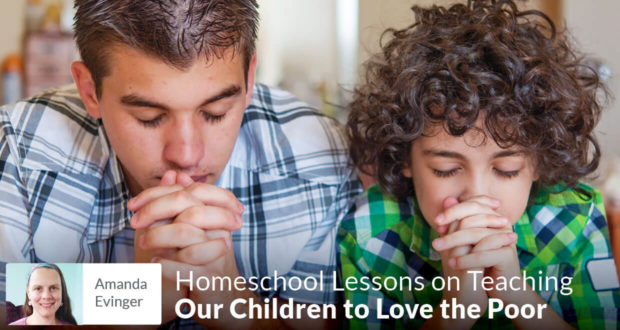Summary
Amanda Evinger on the spirituality behind charitable service and the joy of loving the poor and how to integrate the two into the homeschooling way of life.“Keep the joy of loving the poor and share it with all you meet. Remember, works of love are works of peace.” –St. Teresa of Calcutta
Yesterday, my friend told me she and her husband are hoping to adopt two orphans from Haiti. They already have six children, all under 14, I believe, so I was astounded at their hopeful plans to take in two more children.
Then, she proceeded to tell me she really needed someone who cares about the poor to be praying for them, and to support them as they go through the difficult adoption process. She said that person was me. I was taken aback by her comment — true, I had done a couple of years of full-time missionary work with Mother Teresa’s Sisters as a single person, but since I have gotten married, I can’t say I have been “someone who really cares about the poor.”
Much of this is because I have been consumed with the duties of my state in life, namely mothering and homeschooling, which is what God has been asking of me. And yet, her comment and her plans have made me feel a bit convicted.
They have gotten my “Lenten wheels” turning, and I am finding myself wondering if there are more ways I could be teaching my children to love the poor. Could my children be loving those in need in some new, creative ways? Do we spend enough time in our lives reaching out to others?
This morning, as I prayed through the readings in my Magnificat, I was deeply struck by the following passage from Isaiah 58:
“Thus says the Lord: If you remove from your midst oppression, false accusation and malicious speech; if you bestow your bread on the hungry and satisfy the afflicted; Then light shall rise for you in the darkness and the gloom shall become for you like midday; Then the Lord will guide you always and give you plenty even on the parched land. He will renew your strength, and you shall be like a watered garden, like a spring whose water never fails.”
Here, we see that God promises to bless those who care for the poor in abundant ways. Those who have compassion for the needy are promised incredible rewards, such as light in the darkness, great strength, the gift of life, the guiding hand of the Lord, and the providence of God for their earthly needs. How amazing!
Taking these promises to heart as homeschooling parents, we may ask ourselves questions like: Do we want our families to receive these blessings? Do we want our children to grasp the essence of the Gospel, and feel it resound in their souls?
All of these Saint stories we read to our children — do they cut to the heart or do they go “in one ear and out the other”? Certainly, our schedules are very tight and rightly so.
However, in some small, beautiful fashion, maybe we can help our children love God’s poor, especially during this Lenten Season. Is it our goal to raise self-centered children, or Christ-centered children?
The call of God urges us on. As St. Teresa of Calcutta once said, “How can we love Jesus in the world today? By loving Him in my husband, my wife, my children, my brothers and sisters, my parents, my neighbors, the poor.” And also, “Love is not talking, love is living. I can talk about love the whole day and love not once — looking everywhere, except looking down when there is a man dying in the street.”
Maybe some of us can do the Catholic Relief Service Lenten calendar and rice bowl offering every day until Easter (our family has a bad habit of starting it, and then quitting it half-way through Lent).
Alternatively, maybe we can have our children “adopt” a poor person to pray for and offer their sacrifices up specifically for them throughout this Lenten Season, such as a sick relative, a dying grandparent, or a needy child.
Perhaps we could participate in a program to sponsor a child in a Third World country, or start a regular practice of visiting the nursing home one Sunday a month, bringing our smiling children with us for the residents to enjoy.
We may even be able to start a Prayer Chain at our parish, with our children as some of its intercessors, or we might have our children make cards for someone who is grieving. Alternatively, maybe we have a newborn, and all we can manage to find time for is nursing our baby and praying an extra decade with our children for the poor a few times a week until Easter.
When it comes down to it, there are many wonderful ways we can help the poor, but the most important thing is we put our whole hearts into it, and encourage our children to do the same. This way, we will answer this challenging call from Our Lord, who created all, rich and poor alike.
And, as a result, our home schools will radiate with the mercy and peace of Christ, which comes into our souls when we take those few extra moments to care for those in need.
If we don’t do something for the poor this Lent, who will?
And if we don’t start loving the poor in a new and meaningful way today, when will we?

 Seton Magazine Catholic Homeschool Articles, Advice & Resources
Seton Magazine Catholic Homeschool Articles, Advice & Resources
